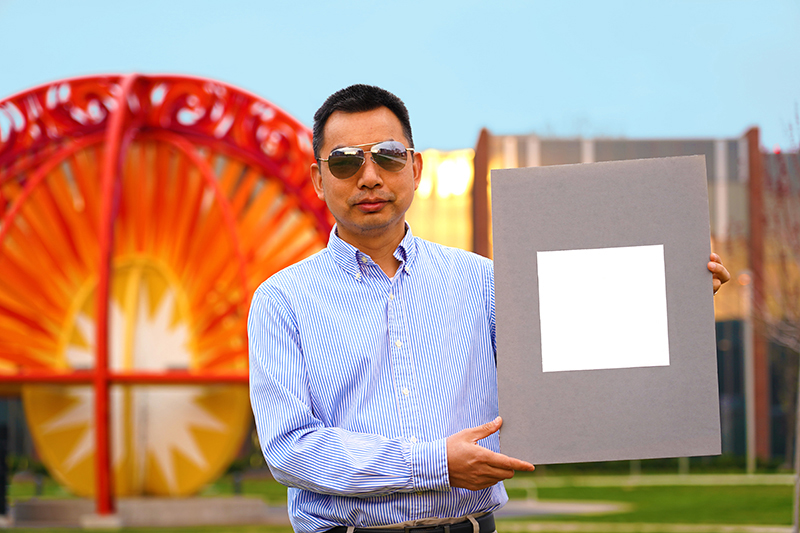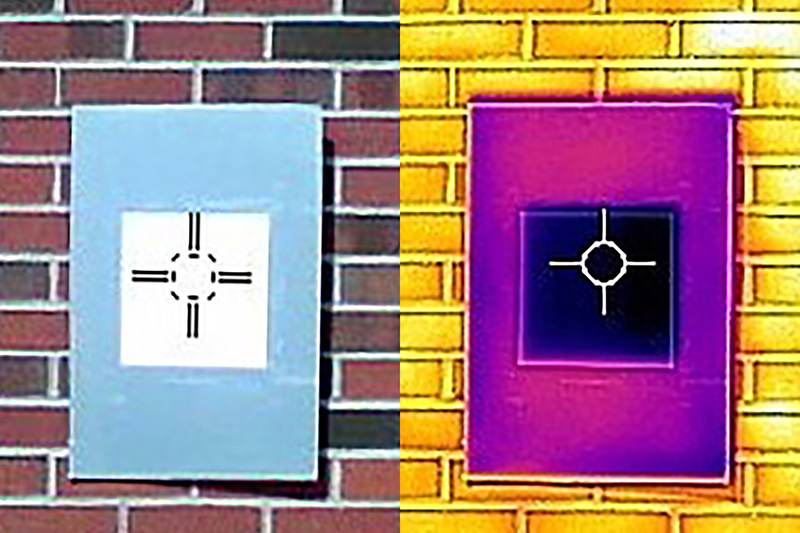April 15, 2021
The whitest paint is here – and it’s the coolest. Literally.

Xiulin Ruan, a Purdue University professor of mechanical engineering, holds up his lab’s sample of the whitest paint on record. (Purdue University/Jared Pike)
New paint formulation could help buildings rely less on air conditioning
WEST LAFAYETTE, Ind. — In an effort to curb global warming, Purdue University engineers have created the whitest paint yet. Coating buildings with this paint may one day cool them off enough to reduce the need for air conditioning, the researchers say.
In October, the team created an ultra-white paint that pushed limits on how white paint can be. Now they’ve outdone that. The newer paint not only is whiter but also can keep surfaces cooler than the formulation that the researchers had previously demonstrated.
“If you were to use this paint to cover a roof area of about 1,000 square feet, we estimate that you could get a cooling power of 10 kilowatts. That’s more powerful than the central air conditioners used by most houses,” said Xiulin Ruan, a Purdue professor of mechanical engineering.
 An infrared camera shows how a sample of the whitest white paint (the dark purple square in the middle) actually cools the board below ambient temperature, something that not even commercial “heat rejecting” paints do. (Purdue University/Joseph Peoples)
Download image
An infrared camera shows how a sample of the whitest white paint (the dark purple square in the middle) actually cools the board below ambient temperature, something that not even commercial “heat rejecting” paints do. (Purdue University/Joseph Peoples)
Download image
The researchers believe that this white may be the closest equivalent of the blackest black, “Vantablack,” which absorbs up to 99.9% of visible light. The new whitest paint formulation reflects up to 98.1% of sunlight – compared with the 95.5% of sunlight reflected by the researchers’ previous ultra-white paint – and sends infrared heat away from a surface at the same time.
Typical commercial white paint gets warmer rather than cooler. Paints on the market that are designed to reject heat reflect only 80%-90% of sunlight and can’t make surfaces cooler than their surroundings.
The team’s research paper showing how the paint works publishes Thursday (April 15) as the cover of the journal ACS Applied Materials & Interfaces.
What makes the whitest paint so white
Two features give the paint its extreme whiteness. One is the paint’s very high concentration of a chemical compound called barium sulfate, which is also used to make photo paper and cosmetics white.
“We looked at various commercial products, basically anything that’s white,” said Xiangyu Li, a postdoctoral researcher at the Massachusetts Institute of Technology, who worked on this project as a Purdue Ph.D. student in Ruan’s lab. “We found that using barium sulfate, you can theoretically make things really, really reflective, which means that they’re really, really white.”
The second feature is that the barium sulfate particles are all different sizes in the paint. How much each particle scatters light depends on its size, so a wider range of particle sizes allows the paint to scatter more of the light spectrum from the sun.
“A high concentration of particles that are also different sizes gives the paint the broadest spectral scattering, which contributes to the highest reflectance,” said Joseph Peoples, a Purdue Ph.D. student in mechanical engineering.
There is a little bit of room to make the paint whiter, but not much without compromising the paint.
“Although a higher particle concentration is better for making something white, you can’t increase the concentration too much. The higher the concentration, the easier it is for the paint to break or peel off,” Li said.
How the whitest paint is also the coolest
The paint’s whiteness also means that the paint is the coolest on record. Using high-accuracy temperature reading equipment called thermocouples, the researchers demonstrated outdoors that the paint can keep surfaces 19 degrees Fahrenheit cooler than their ambient surroundings at night. It can also cool surfaces 8 degrees Fahrenheit below their surroundings under strong sunlight during noon hours.
The paint's solar reflectance is so effective, it even worked in the middle of winter. During an outdoor test with an ambient temperature of 43 degrees Fahrenheit, the paint still managed to lower the sample temperature by 18 degrees Fahrenheit.
This white paint is the result of six years of research building on attempts going back to the 1970s to develop radiative cooling paint as a feasible alternative to traditional air conditioners.
Ruan’s lab had considered over 100 different materials, narrowed them down to 10 and tested about 50 different formulations for each material. Their previous ultra-white paint was a formulation made of calcium carbonate, an earth-abundant compound commonly found in rocks and seashells.
The researchers showed in their study that like commercial paint, their barium sulfate-based paint can potentially handle outdoor conditions. The technique that the researchers used to create the paint also is compatible with the commercial paint fabrication process.
Patent applications for this paint formulation have been filed through the Purdue Research Foundation Office of Technology Commercialization. This research was supported by the Cooling Technologies Research Center at Purdue University and the Air Force Office of Scientific Research through the Defense University Research Instrumentation Program (Grant No.427 FA9550-17-1-0368). The research was performed at Purdue’s FLEX Lab and Ray W. Herrick Laboratories and the Birck Nanotechnology Center of Purdue’s Discovery Park.
About Discovery Park
Discovery Park is a place where Purdue researchers move beyond traditional boundaries, collaborating across disciplines and with policymakers and business leaders to create solutions for a better world. Grand challenges of global health, global conflict and security, and those that lie at the nexus of sustainable energy, world food supply, water and the environment are the focus of researchers in Discovery Park. The translation of discovery to impact is integrated into the fabric of Discovery Park through entrepreneurship programs and partnerships.
About Purdue University
Purdue University is a top public research institution developing practical solutions to today’s toughest challenges. Ranked the No. 5 Most Innovative University in the United States by U.S. News & World Report, Purdue delivers world-changing research and out-of-this-world discovery. Committed to hands-on and online, real-world learning, Purdue offers a transformative education to all. Committed to affordability and accessibility, Purdue has frozen tuition and most fees at 2012-13 levels, enabling more students than ever to graduate debt-free. See how Purdue never stops in the persistent pursuit of the next giant leap at https://purdue.edu/.
Writer, Media contact: Kayla Wiles, 765-494-2432, wiles5@purdue.edu
Source: Xiulin Ruan, ruan@purdue.edu
Journalists visiting campus: Journalists should follow Protect Purdue protocols and the following guidelines:
- Campus is open, but the number of people in spaces may be limited. We will be as accommodating as possible, but you may be asked to step out or report from another location.
- To enable access, particularly to campus buildings, we recommend you contact the Purdue News Service media contact listed on the release to let them know the nature of the visit and where you will be visiting. A News Service representative can facilitate safe access and may escort you on campus.
- Correctly wear face masks inside any campus building, and correctly wear face masks outdoors when social distancing of at least six feet is not possible.
ABSTRACT
Ultra-white BaSO4 Paints and Films for Remarkable Daytime Subambient Radiative Cooling
Xiangyu Li, Joseph Peoples, Peiyan Yao and Xiulin Ruan
DOI: 10.1021/acsami.1c02368
Radiative cooling is a passive cooling technology that offers great promises to reduce space cooling cost, combat the urban island effect and alleviate the global warming. To achieve passive daytime radiative cooling, current state-of-the-art solutions often utilize complicated multilayer structures or a reflective metal layer, limiting their applications in many fields. Attempts have been made to achieve passive daytime radiative cooling with single-layer paints, but they often require a thick coating or show partial daytime cooling. In this work, we experimentally demonstrate remarkable full daytime sub-ambient cooling performance with both BaSO4 nanoparticle films and BaSO4 nanocomposite paints. BaSO4 has a high electron bandgap for low solar absorptance and phonon resonance at 9 µm for high sky window emissivity. With an appropriate particle size and a broad particle size distribution, BaSO4 nanoparticle film reaches an ultra-high solar reflectance of 97.6% and high sky window emissivity of 0.96. During field tests, BaSO4 film stays more than 4.5°C below ambient temperature or achieves average cooling power of 117 W/m2. BaSO4-acrylic paint is developed with 60% volume concentration to enhance the reliability in outdoor applications, achieving solar reflectance of 98.1% and sky window emissivity of 0.95. Field tests indicate similar cooling performance to the BaSO4 films. Overall, our BaSO4-acrylic paint shows standard figure of merit of 0.77 which is among the highest of radiative cooling solutions while providing great reliability, the convenient paint form, ease of use and the compatibility with commercial paint fabrication process.
Note to journalists: For a copy of the paper, please contact Kayla Wiles, Purdue News Service, at wiles5@purdue.edu or 765-494-2432. Photos of the whitest paint are available via Google Drive. Journalists visiting campus should follow visitor health guidelines.

